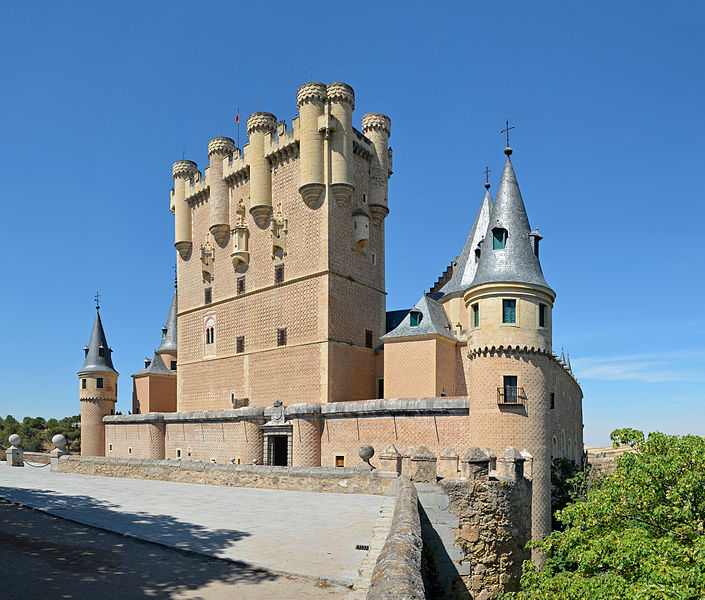EL CAPRICHO Park
When looking at our blog you will be convinced that all we do is tour historic sites and walk around parks. That's not the case, but as boring as it might be to browse through such blogs, it would be even more boring if we blogged the other places we go and the other things we do. I mean, how many pictures of the Metro and of the grocery stores, etc would a person find interesting?Or how many pictures of going up and down the elevators at the MTC all day and night.
So, thankfully, we're blogging historic sites and gardens.
Much better.
About 3 weeks ago we took a day trip with 2 couples serving temple missions here in Madrid; the Jones' and the Zimmermans. They are proficient in Spanish and both know the city very well, so they allowed us to tag along. They took us walking through 2 very large parks, one covering several square miles. But I chose to introduce you to the one that was the most enchanting and delightful. It was a beautiful spring day with trees and bushes and gardens in full bloom.
So, please enjoy "The Garden of Caprice"
Though very much unknown and out of the way, the garden of El Capricho (literally, a whim) is one of the most beautiful and attractive parks in the city.
The 14-hectare garden, located in the area of the Barajas district, dates back to 1784 when the Duke of Osuna, from one of the most illustrious and powerful of the city’s families, acquired the land for the specific purpose of giving expression to the family’s artistic values as well as to give them a place to escape city life. The prime mover was the Duchess Lady María Josefa de la Soledad Alonso Pimentel. Thought to be among the most intelligent women of her time, and a patron to many artists, bull-fighters and intellectuals, she designed the garden bearing in mind a sort of artistic-nature retreat for the more illustrious figures of her day and to which the most prestigious gardeners and artists offered help in designing.
After she died, her eldest grandchild inherited the duchy of Osuna, along with El Capricho garden. The park was maintained throughout his life, but following his death the property passed on to one of his brothers, under who’s oversight the gardens fell into disrepair. Profligate and eccentric, he set about losing the family fortune, to such a point that after his death it was necessary to sell the garden in order to pay off debts.
It was acquired by the Baüer family, which did its best to keep up the property, but the decline was already too far gone, and it was necessary to slowly get rid of some of the holdings.
During the Spanish Civil War another change came about; what was once considered a place for leisure and strolling became the Staff Headquarters of the Central Army. At the end of the war, the property passed through a number of different hands, until it was bought by the Town Hall in 1974, followed by renovation works carried out several years later.
 |
| Entering the park one passes through a miniature bull-fighting ring. |
 |
| All through the park these trees were fantastic. And lilacs were everywhere in bloom. |
 |
| Lovely maidens of the Park, Sister Zimmerman and Vivienne |
 |
| Sister Jones. Someone who never learned how to frown. |
 |
| This is how I want my backyard to look in a couple of years. Nice tiled drainage on the sides of the path, all leveled and manicured. |
 |
| Romantic |
 |
| Miniature Dance Hall accessed by boat on canals or by footpath. |
 |
| Figures in relief on the Dance Hall, or Casino de Baille |
 |
| Dance Hall |
 |
| Entrance to Dance Hall from the boat dock. |
 |
| Beautiful walking paths with a look towards the pond in the middle of the canals where small boats plied. |
 |
| This is also how I want my back yard to look |
 |
| A moment's reflection in a place of serenity. Nobility certainly had its advantages in times past. |
 |
| The black swan was friendly but demonstrably disappointed that we did not bring food. |
 |
| The small boat dock and the end of the path leading to the personal residence. |
 |
| A less-trodden path near one of the boat canals. I thought of Frost's "The Road Less Taken" |
 |
| Scott Zimmerman, the man, the camera. Inseparable. |
 |
| An old and unusual tree. Seemingly continually reborn with new shoots. I think there's some kind of lesson there. |
 |
| Garish but charming battlement built during the Spanish Civil War when the Gardens were turned into a military post. A battery of artillery was placed in the middle. |
 |
| There was a wonderful fragrance around this area. I wish smells could be blogged. Well, OK, SOME smells........ |
 |
| Another "Road Less Taken" moment |
 |
| A miniaturized Hellenic temple. This stuff has all been around since the founding of our nation. Really beautiful |
 |
| Looking from the porch and staircase of the family residence. Off to the left were gardens created just for children to play in. |
 |
| Gigantic Sycamore tree. Reminded me of Doug Olson's front yard. Only 3 times bigger. |
 |
| Large maze. I thought I was in a Harry Potter movie, the hedges were about 8 feet tall. They did not allow us in. A good thing; Vivienne would never have found her way out. |































